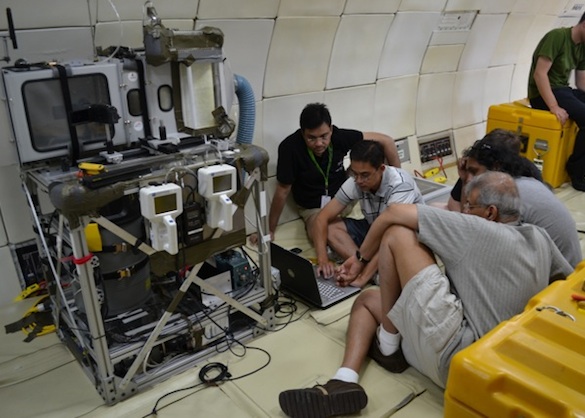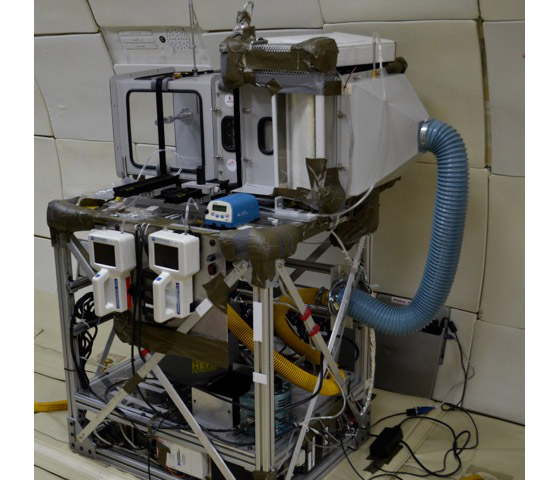Indexing Media Filtration System
PI: Rajagopal Vijayakumar, Aerfil, LLC, Juan Agui (Co-I), NASA/Glenn Research Center
PI: Rajagopal Vijayakumar, Aerfil, LLC, Juan Agui (Co-I), NASA/Glenn Research Center

- TA06 Human Health, Life Support and Habitation Systems
A novel multi-stage filter system to meet the objectives has been designed under an Innovative Partnership Program (IPP) project between NASA and AERFIL and its partners, Filtration Group Incorporated and Spectrum Filtration. The prototype of the filtration system built and proposed for these flights is constructed of three stages: (1) a pre-filter stage for removing the large particles, (2) a medium efficiency second stage for removing the smaller particles and (3) a high efficiency final or finishing filter stage to provide high quality air. These stages are packaged into a compact interchangeable cartridge type design to allow for testing individual stages. This modular design also provides the flexibility to add more stages of filters for performance optimization, and to meet design and operational requirements of any NASA mission. Two generations of the system have been built, with private enterprise committing the majority of the effort at no cost to NASA.
Both versions have been tested in the laboratory at GRC as well in micro gravity during NASA’s reduced gravity flight campaigns in 2010 and 2011. Results from these tests indicate that the technology readiness level of the proposed system is TRL-4 and has partially met the requirements for TRL-5. Further analyses of the data from the recently concluded flight testing in August 2012 may further the maturation of the technology to TRL-6 or better.
The main customer for the indexing media filtration system is the Life Support and Habitation Systems (LSHS) foundational domain which supports its development through the Particulate Removal Task. In addition, the In-situ Resource Utilization (ISRU) foundational domain - Dust Removal task is also interested in it as a potential gas filter for the processing of the Martian atmosphere for CO2 extraction.
We propose to test and evaluate this system for the following criteria under near zero-g, lunar-g and Martian-g conditions and compare the low-g performance with that at 1g obtained at Glenn Research Center: (1) the ability to separate and capture particles 0.1 micron and above with greater than 99% efficiency at simulated low and reduced gravity, (2) pressure drop across each stage of the system, (3) dust collection efficiency and demonstrate operation of each stage, (4) overall system flow rate, (5) in-place filter system operation, (6) operational lifetime from extrapolated data, (7) maintenance requirements, (8) reduced or microgravity operation of the system, and (9) power consumption requirements. In addition we will obtain high-speed digital video data of particle flow through the system wherever practical to provide a visual record of the system operations and flow characteristics at low and zero-g.
The payload for parabolic flights consists of the flight test rig and the filter system. The test rig is fully instrumented to provide visual flow information and to determine the performance of the filter system. A HEPA vacuum is used to induce the air flow through the flow duct apparatus and filter the exhaust air prior to release into the aircraft cabin. A custom-designed particle generator is used to disperse challenge particles into the flow, and two optical particle counters (OPC’s) are used to determine particle capture efficiency (or filter efficiency) by measuring the particle counts upstream and downstream of the filter sections.

The Flight Opportunities Program (FOP) Zero-G flight campaign provided a unique opportunity to test the hardware for microgravity effects through multiple simulated zero-gravity periods (parabolas). Since this technology has significant commercial potential and patents are being applied for, detailed performance data are not available for disclosure at this time.
The data obtained in the August 2012 flight campaign will be used to compare the performance of the filter system with its operation in normal gravity. In the spirit of international partnership, the flight campaign brought together government and industry researchers and product developers, including additional filter company sponsors from India (Spectrum Filtration) and Brazil (Trox do Brasil), to participate in the hardware testing and experience the feeling of weightlessness made possible through NASA’s Flight Opportunities Program. Maturation of this technology has proprietary elements that are in the process of being appropriately protected.
Technology Details
-
Selection DateAFO1 (May 2011)
-
Program StatusCompleted
- 4 Parabolic
Development Team
-
PIRajagopal Vijayakumar
-
PI Organization
-
Co-IJuan Agui
-
Co-I Organization
-
SponsorAerfil, NASA
-
More Information

